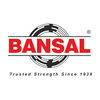Filter interviews by
JAY JAGDAMBA Metallurgical Engineer Interview Questions and Answers
JAY JAGDAMBA Metallurgical Engineer Interview Experiences
1 interview found

(2 Questions)
- Q1. Personal information
- Q2. Basic information about the industry.
Interview Preparation Tips
Clear all the things before join.
Accommodation perk duty hours.
Nice employee cooperation.
Top trending discussions






Interview questions from similar companies

I applied via Referral and was interviewed before Mar 2023. There were 3 interview rounds.
(1 Question)
- Q1. Technical related to applied position
(1 Question)
- Q1. Technical & general discussion
(1 Question)
- Q1. Salary & General background details
Senior Quality Engineer Interview Questions & Answers
Aeroflex Industriesposted on 27 Aug 2024
I applied via Referral and was interviewed before Aug 2023. There were 2 interview rounds.
(2 Questions)
- Q1. Iso 9001 clauses
- Q2. Qc tools,principles,problem solving, customer complaint handling
(2 Questions)
- Q1. Salary acceptations
- Q2. Experience,relocate

I applied via Naukri.com and was interviewed in Aug 2021. There were 2 interview rounds.

(5 Questions)
- Q1. What are tha fuction of otto cycle and Diesel Cycle?
- Ans.
Otto cycle is used in gasoline engines and Diesel cycle is used in diesel engines.
Otto cycle is a constant volume cycle used in gasoline engines.
Diesel cycle is a constant pressure cycle used in diesel engines.
Otto cycle has a higher compression ratio compared to Diesel cycle.
Otto cycle has a spark plug for ignition while Diesel cycle uses compression ignition.
Both cycles involve four processes: intake, compression, po
- Q2. Different b/w Stress and Strain?
- Ans.
Stress is the force applied to a material, while strain is the resulting deformation or change in shape.
Stress is a measure of the internal forces within a material, while strain is the measure of the deformation or change in shape.
Stress is typically measured in units of force per unit area (such as N/m^2 or Pa), while strain is a dimensionless quantity.
Stress can cause a material to deform or break, while strain is t...
- Q3. How many types of Ramming mass?
- Ans.
There are two main types of Ramming mass: acidic and basic.
Acidic Ramming Mass: used for lining induction furnaces and arc furnaces.
Basic Ramming Mass: used for lining steel ladles and EAF (Electric Arc Furnace).
- Q4. How Many Types of Steel?Explained tha percentage of Steel?
- Ans.
There are several types of steel, each with different properties and uses. The percentage of steel in a particular alloy can vary.
Types of steel include carbon steel, alloy steel, stainless steel, tool steel, and high-speed steel.
The percentage of steel in an alloy can range from as low as 0.2% to as high as 2.1% depending on the type of steel and its intended use.
For example, carbon steel typically contains around 0.2...
- Q5. Explain Thermodynamics Law 1st 2nd and 3 rd?
- Ans.
First law states energy cannot be created or destroyed, second law states entropy always increases, third law states entropy approaches zero at absolute zero.
First Law: Energy cannot be created or destroyed, only transferred or converted. Example: A car engine converts fuel into mechanical energy.
Second Law: Entropy of an isolated system always increases over time. Example: Heat always flows from hot to cold objects.
Th...
Interview Preparation Tips

I applied via Naukri.com and was interviewed in Aug 2022. There were 3 interview rounds.

(3 Questions)
- Q1. About my past experiences
- Q2. About project cost handling
- Q3. How to complete project withing time span
- Ans.
To complete a project within the time span, proper planning, delegation, and monitoring are essential.
Create a detailed project plan with clear timelines and milestones
Delegate tasks to team members based on their strengths and expertise
Regularly monitor progress and make adjustments as needed
Communicate effectively with team members to ensure everyone is on the same page
Use project management tools to streamline proce
(1 Question)
- Q1. Genral Questions like Salary negotiations location
Interview Preparation Tips

Assistant Manager Interview Questions & Answers
Bharat Wire Ropesposted on 2 Oct 2024
The HR policy is very bad. The notice period there is 2 months for Assistant Manager and 3 months for Deputy Manager. If you do not serve the notice period, they deduct the gross salary and not the basic salary. And they do not give any full and final breakup certificate.
Because the company I was joining had bought my notice period. But Bharat Wire did not give me any full and final breakup certificate. Due to this, the company I joined did not give me the notice period money. My amount was about 83000 rupees. My money got lost because of Bharat Wire.
I emailed HR many times. But HR did not reply to my email.
If I talk specifically about the electrical department, there is rule of two people who talk like non-technical. And they do not have the manners to talk to seniors and juniors. Only those who do not know anything and who can bear their abuses are working there.
I would especially refuse to join this electrical department as long as these people are there. Even if you join there, within a week you will feel that we took a wrong decision. And you will be mentally stressed. Because you will be tortured so much. The electrical department has a completely toxic environment.
The canteen food is absolutely bad. Even dogs would not like such food.
Bharat Wire had a very good image in the market long ago. People wanted to join this company.
but today no one wants to join Bharat Wire whoever comes to know about it. That is why before joining, people connect with people on LinkedIn and take feedback, which is also right.

I applied via Naukri.com and was interviewed in Apr 2024. There was 1 interview round.
(2 Questions)
- Q1. Technical and server related questions
- Q2. Current CTC related questions
Interview Preparation Tips

Production Supervisor Interview Questions & Answers
Peekay Steel Castingsposted on 4 Mar 2022
I applied via Referral and was interviewed in Apr 2022. There were 3 interview rounds.
Questions related to your position and department
(1 Question)
- Q1. Technical questions related to your skills, experience and knowledge
(1 Question)
- Q1. Questions related to previous profile and experience
Interview Preparation Tips

Marketing Assistant Interview Questions & Answers
Peekay Steel Castingsposted on 26 Apr 2023
I applied via Approached by Company and was interviewed before Apr 2022. There were 2 interview rounds.

(2 Questions)
- Q1. What is molarity
- Ans.
Molarity is a measure of the concentration of a solution in terms of the number of moles of solute per liter of solution.
Molarity is expressed in units of moles per liter (mol/L).
It is used to calculate the amount of solute in a solution.
For example, a 1 M solution of sodium chloride contains 1 mole of sodium chloride per liter of solution.
Molarity is often used in chemistry and biochemistry to describe the concentrati
- Q2. Carbon allotropes
Interview Preparation Tips

I appeared for an interview in Oct 2024.
(2 Questions)
- Q1. What About concrete mix?
- Ans.
Concrete mix refers to the combination of ingredients used to create concrete, including cement, aggregates, water, and admixtures.
Concrete mix typically consists of cement, aggregates (such as sand and gravel), water, and sometimes admixtures.
The ratio of these ingredients can vary depending on the desired strength, workability, and durability of the concrete.
For example, a common concrete mix for general use is 1 par...
- Q2. What is retarder in concrete mix?
- Ans.
Retarder in concrete mix is a chemical additive used to slow down the setting time of concrete.
Retarders help in preventing the concrete from setting too quickly, allowing more time for placement and finishing.
They are commonly used in hot weather conditions to prevent premature setting.
Examples of retarders include lignosulfonates, sugars, and citric acid.
Interview Preparation Tips
JAY JAGDAMBA Interview FAQs
Tell us how to improve this page.
JAY JAGDAMBA Interviews By Designations
Interview Questions for Popular Designations
- Metallurgist Interview Questions
- Quality Engineer Interview Questions
- Graduate Engineer Trainee (Get) Interview Questions
- Production Engineer Interview Questions
- Operator Interview Questions
- Electrical Engineer Interview Questions
- Junior Engineer Interview Questions
- Metallurgy Engineer Interview Questions
- Show more
JAY JAGDAMBA Metallurgical Engineer Interview Process
based on 1 interview
Interview experience
Interview Questions from Similar Companies
|
Executive Accountant
8
salaries
| ₹2.6 L/yr - ₹4 L/yr |
|
Accountant
6
salaries
| ₹2.4 L/yr - ₹6 L/yr |
|
Export Executive
6
salaries
| ₹2 L/yr - ₹4.8 L/yr |
|
Production Supervisor
6
salaries
| ₹1.5 L/yr - ₹2.7 L/yr |
|
Senior Accounts Executive
6
salaries
| ₹3.5 L/yr - ₹6 L/yr |

Bharat Wire Ropes

Steel Infra Solutions

Peekay Steel Castings

Mahindra Accelo
- Home >
- Interviews >
- JAY JAGDAMBA Interview Questions >
- JAY JAGDAMBA Metallurgical Engineer Interview Questions








